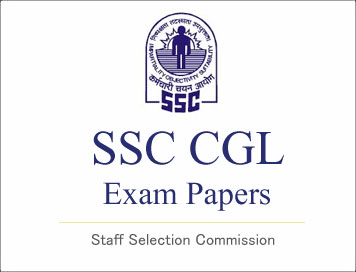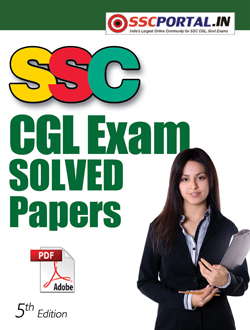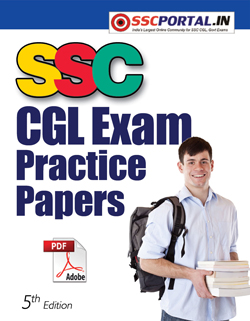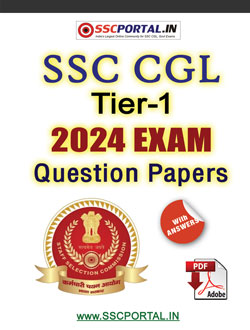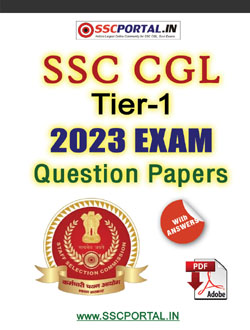NEW! SSC CGL PDF NOTES
SSC CGL (Tier - 1) Previous Year Solved Paper - 2011, 2nd shift "Numerical Aptitude"
SSC CGL (Tier - 1, 1st shift) Previous Year Solved Paper - 2011
Subject: Numerical Aptitude
1.

(a) 1439/9
(b) 160
(c) 1443/9
(d) 169
2. The sum of two numbers is 24 and their product is 143. The sum of their square is
(a) 296
(b) 295
(c) 290
(d) 228
3. Which one of the following will completely divide 571 + 572 + 5 73 ?
(a) 150
(b) 160
(c) 155
(d) 30
4. L.C.M. of two numbers is 120 and their H.C.F. is 10. Which of the following can be the sum of those two numbers?
(a) 140
(b) 80
(c) 60
(d) 70
5. When ‘n’ is divided by 5 the remainder is 2. What is the remainder when n2 is divided by 5?
(a) 2
(b) 3
(c) 1
(d) 4
6. A student was asked to divide a number by 6 and add 12 to the quotient. He, however, first added 12 to the number and then divided it by 6, getting 112 as the answer. The correct answer should have been
(a) 124
(b) 122
(c) 118
(d) 114
7. Four runners started running simultaneously from a point on a circular track. They took 200 seconds, 300 seconds, 360 seconds and 450 seconds to complete the round. After how much time to they meet at the starting point for the first time?
(a) 1800 seconds
(b) 3600 seconds
(c) 2400 seconds
(d) 4800 seconds
8. ‘x’ number of men can finish a piece of work is 30 days. If there were 6 men more, the work culd be finished in 10 days less. The original number of men is
(a) 6
(b) 10
(c) 12
(d) 15
9. A work can be completed by P and Q in 12 days, Q and R in 15 days, R and P in 20 days. In how many days P alone can finish the work?
(a) 10
(b) 20
(c) 30
(d) 60
10. A is thrice as good a workman as B and is, therefore, able to finish a piece of work in 60 days less than B. The time (in days) in which they can do it working together is
(a) 22
(b) 45/2
(c) 23
(d) 93/4
11. A copper wire is bent in the form of square with an area of 121 cm 2. If the same wire is bent in the form of a circle, the radius (in cm) of the circle is
(a) 7
(b) 10
(c) 11
(d) 14
12. The areas of three consecutive faces of a cuboid are 12 cm 2, 20cm 2 and 15 cm 2, then the volume (in cm 3) of the cuboid is
(a) 3600
(b) 100
(c) 80
(d) 60
13. Water is flowing at the rate of 5 km/h through a pipe of diameter 14 cm into a rectangle tank which is 50 m long, 44 m wide. The time taken, in hours, for the rise in the level of water in the tank to be 7 cm is
(a) 2
(b) 3/2
(c) 3
(d) 5/2
14. The wheel of a motor car makes 1000 revolution in moving 440 m. The diameter (in meter) of the wheel is
(a) 0.44
(b) 0.14
(c) 0.24
(d) 0.34
15. The sides of a triangle are in the ration 2 : 3 : 4. The perimeter of the triangle is 18 cm. The area (in cm 2) of the triangle is
(a) 9
(b) 36
(c)
(d)
16. Marked price of an article is Rs. 275. Shopkeeper allows a discount of 5% and he gets a profit of 4.5%. The actual cost of the article is
(a) 250
(b) 225
(c) 215
(d) 210
17. The difference between a discount of 40% on Rs. 500 and two successive discounts of 36%, 4% on the same amount is
(a) Rs. 0
(b) Rs. 2
(c) Rs. 1.93
(d) Rs. 7.20
18. If x : y = 4 : 5, then
(3x + y) : (5x + 3y) =
(a) 3 : 5
(b) 5 : 3
(c) 17 : 35
(d) 35 : 17
19. The ratio of the quantities on an acid and water in a mixture is 1 : 3. If 5 liters of acid is further added to the mixture, the new ratio becomes 1 : 2. The quantity of new mixture in litres is
(a) 32
(b) 40
(c) 42
(d) 45
20. The ratio between two numbers is 2 : 3. If each number is increased by 4, the ratio between them becomes 5 : 7. The difference between the numbers is
(a) 8
(b) 6
(c) 4
(d) 2
21. Monthly incomes of A and B are in the ratio of 4 : 3 and their expenses bear the ratio 3 : 2. Each of them saves Rs. 6,000 at the end of the month, then the monthly income of A is
(a) Rs. 12,000
(b) Rs. 24,000
(c) Rs. 30,000
(d) Rs. 60,000
22. The average of three consecutive odd numbers is 12 more than one third of the first of these numbers. What is the last of the three numbers?
(a) 15
(b) 17
(c) 19
(d) Data inadequate
23. The average of 18 observations is recorded as 124. Later it was found that two observations with values 64 and 28 were entered wrongly as 46 and 82. Find the correct average of the 18 observations.
(a) 895/8
(b) 122
(c) 123
(d)
24. If the cost price of 15 articles is equal to the selling price of 12 articles, find gain%
(a) 20
(b) 25
(c) 18
(d) 21
25. The cost price of an article is 64% of the marked price. The gain percentage after allowing a discount of 12% on the market price is
(a) 37.5%
(b) 48%
(c) 50.5%
(d) 52%
26. A man purchased some eggs at 3 for Rs. 5 and sold them at 5 for Rs. 12. Thus he gained Rs. 143 in all. The number of eggs he bought is
(a) 210
(b) 200
(c) 195
(d) 190
27. X cells two articles for Rs. 4,000 each with no loss and no gain in the interaction. If one was sold at a gain of 25% the other is sold at a loss of
(a) 25%
(b) %
(c) 50 / 3%
(d) 20%
28. 20% loss on selling price is what per cent loss on the cost price?
(a) 25%
(b) 15%
(c)50 / 3 %
(d) 49 / 3%
29. If 90% of A = 30% of B and B = x% of A, then the value of x is
(a) 800
(b) 300
(c) 700
(d) 400
30. A reduction of 20% in the price of sugar enables me to purchase 5 kg more for Rs. 600. Find the price of sugar per kg before reduction of price.
(a) Rs. 24
(b) Rs. 30
(c) Rs. 32
(d) Rs. 36
31. The price of a commodity rises from Rs. 6 per kg to Rs. 7.50 per kg. If the expenditure cannot increase, the percentage of reduction in consumption is
(a) 15
(b) 20
(c) 25
(d) 30
32. First and second numbers are less than a third number by 30% and 37% respectively. The second number is less than the first by
(a) 7%
(b) 4%
(c) 3%
(d) 10%
33. Walking at 6/7th of this usual speed a man is 25 minutes too late. His usual time to cover this distance is
(a) 2 hours 30 minutes
(b) 2 hours 15 minutes
(c) 2 hours 25 minutes
(d) 2 hours 10 minutes
34. Walking at 5 km/hr a student reaches his school from his house 15 minutes early and walking at 3 km/hr he is late by 9 minutes. What is the distance between his school and his house?
(a) 5 km
(b) 8 km
(c) 3 km
(d) 2 km
35. A sum of Rs. 12,000 deposited at compound interest becomes double after 5 years. After 20 years, it will become
(a) Rs. 48,000
(b) Rs. 96,000
(c) Rs. 1,90,000
(d) Rs. 1,92,000
36. Simple interest on a certain sum for 6 years is 9/25of the sum. The rate of interest is
(a) 6%
(b) 13/2%
(c) 8%
(d) 17/2%
37. The difference between the compound interest and simple interest for the amount Rs. 5,000 in 2 years is Rs.32. The rate of interest is
(a) 5%
(b) 8%
(c) 10%
(d) 12%
38. The least number, which is to be added to the greatest number of 4 digits so that the sum may be divisible by 345, is
(a) 50
(b) 6
(c) 60
(d) 5
39.
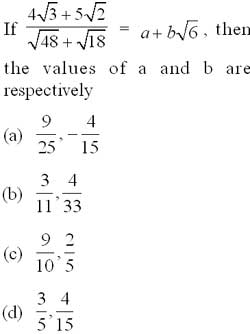
40. If 17200 is divided by 18, the remainder is
(a) 1
(b) 2
(c) 16
(d) 17
41.
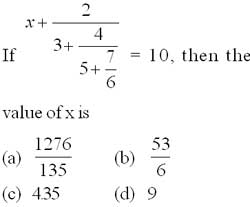
42. The unit digit in the sum of (124) 372 + (124)373 is
(a) 5
(b) 4
(c) 20
(d) 0
43.
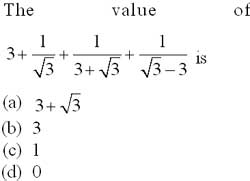
44. If a * b = ab, then the value of 5 * 3 is
(a) 125
(b) 243
(c) 53
(d) 15
45.

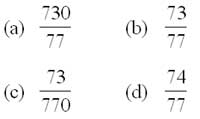
46. If = 0.3 × 0.3 × value of is
(a) 0.009
(b) 0.03
(c) 0.09
(d) 0.08
Directions (47-50): The following graph shows the production of cotton bales of 100 kg each in lakhs by different states A, B, C, D and E over the years. Study the graph and answer the following Questions.
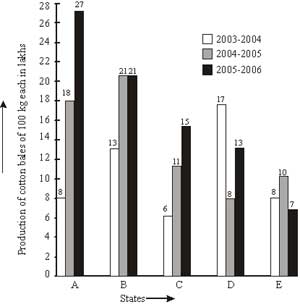
47. The production of State C in 2003-2004 is how many times its production in 2005-2006?
(a) 2.5
(b) 1.85
(c) 1.5
(d) 0.4
48. In which State(s) is there a steady increase in the production of cotton during the given period?
(a) A and B
(b) B and D
(c) A and C
(d) D and E
49. How many kg of cotton was produced by State C during the given period?
(a) 32,00,00,000 kg
(b) 42,50,00,000 kg
(c) 33,00,00,000 kg
(d) 35,00,00,000 kg
50. The number of States for which the production of cotton in 2005-2006 is less than or equal to the preceding year is
(a) 3
(b) 2
(c) 1
(d) There is no such States
Answer Key
| 1.b | 6.b | 11.a | 16.a | 21.b | 26.c | 31.b | 36.a | 41a | 46. |
| 2.c | 7.a | 12.d | 17.d | 22.c | 27.d | 32.d | 37.b | 42.d | 47.d |
| 3.c | 8.c | 13.a | 18.c | 23.b | 28.b | 33.a | 38.b | 43.b | 48.c |
| 4.a | 9.c | 14.b | 19.c | 24.b | 29.b | 34.c | 39.d | 44.a | 49.a |
| 5.d | 10.b | 15.d | 20.a | 25.a | 30.a | 35.d | 40.a | 45.b | 50.b |
(E-Book) SSC CGL (Tier-1) Exam Question Papers PDF with Ans Download
Click Here to Join SSC CGL (Tier -1) Online Crash Course
Click Here to Buy SSC CGL (Tier -1) Stud y Kit in Print Copy
<< Go Back to Main Page


